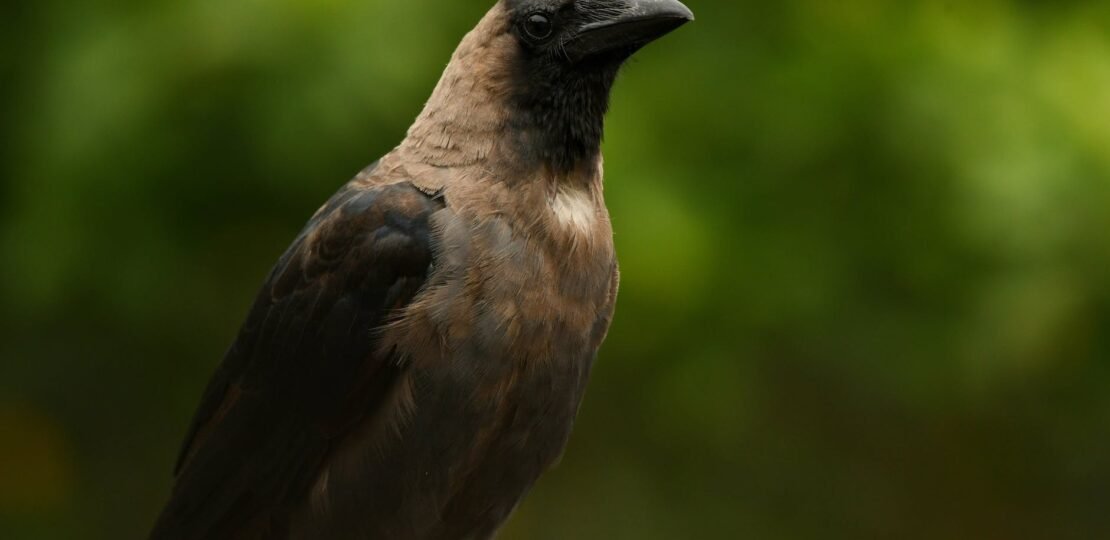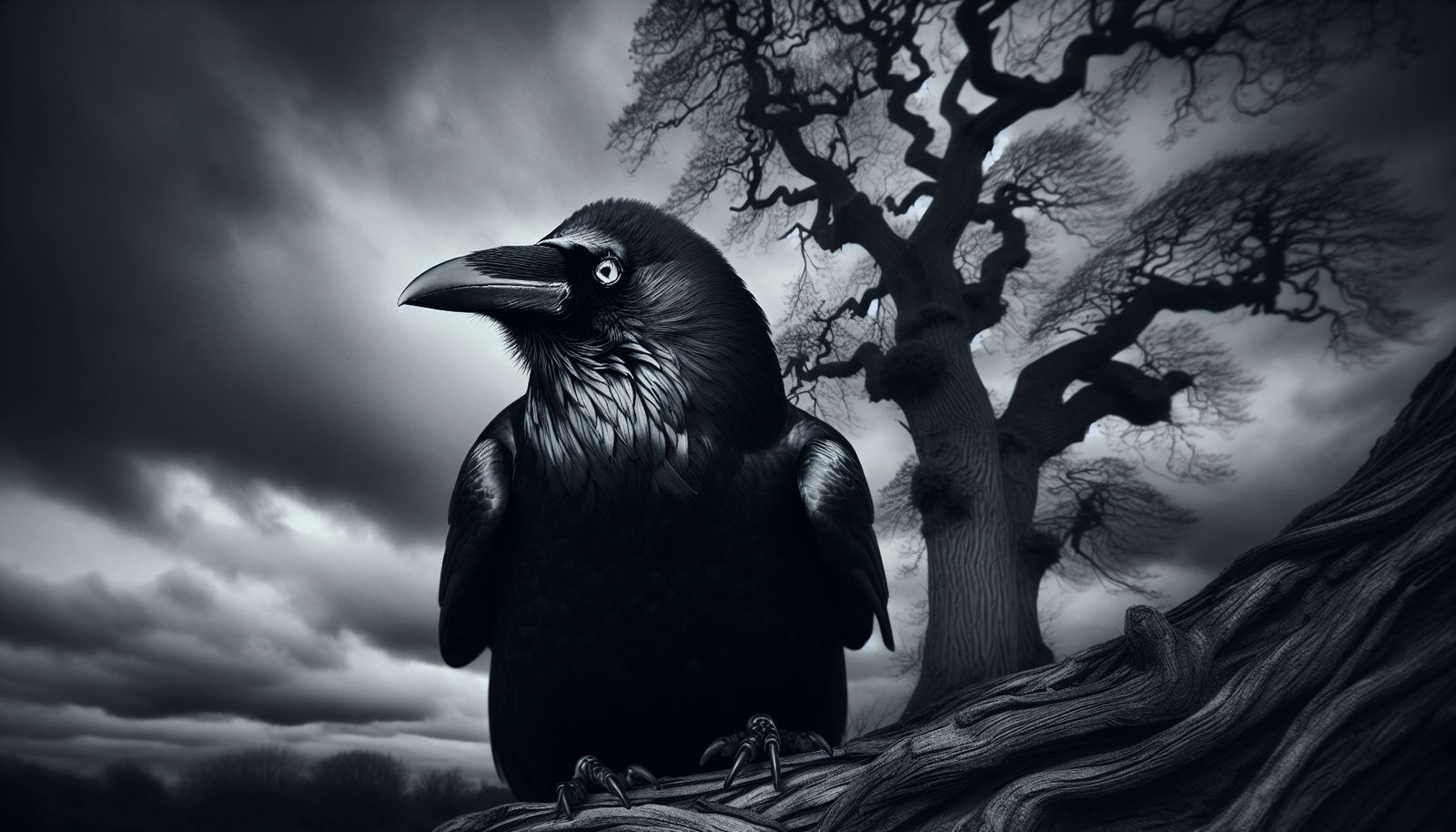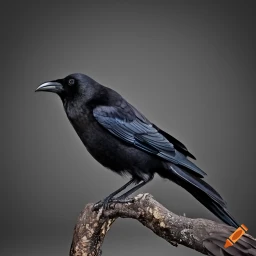In the Shadows: Exploring the Enigmatic Corvus Corax Raven
December 29, 2023 | by BlackCrow.com

Introduction to the Common Raven
The Common Raven, scientifically known as Corvus corax, is a fascinating and enigmatic bird that belongs to the corvid family. This large, black bird is widely distributed across the holarctic regions of the northern hemisphere, including North America, Europe, and Asia. Known for its intelligence and adaptability, the Common Raven has captivated the interest of bird enthusiasts and researchers alike.
Overview of the Corvus Corax Raven
The Common Raven is one of the largest passerine birds, measuring between 22 to 27 inches (56 to 69 cm) in length. It has a robust build, with a wingspan that can reach up to 46 inches (117 cm). The plumage of the Common Raven is entirely black, showcasing a glossy sheen that adds to its striking appearance.
Distribution and Habitat
The Common Raven is a highly adaptable bird, occupying a diverse range of habitats. It can be found in various ecosystems, including forests, tundra, grasslands, and coastal areas. This species has an extensive distribution and can be spotted in regions such as North America, Europe, Asia, and parts of Africa.
In North America, the Common Raven is prevalent throughout the continent, with the exception of the extreme northern and southern regions. In Europe, it is present in both western and eastern parts, while in Asia, it can be found from the Middle East to the Far East. The Common Raven’s ability to thrive in different environments is a testament to its resilience and resourcefulness.
Understanding the common raven’s physical characteristics, behavior, diet, and cultural significance will provide a holistic view of this remarkable bird. In the following sections, we will delve deeper into these aspects, exploring the fascinating world of the Common Raven.
Physical Characteristics
When examining the common raven (Corvus corax), its physical characteristics are truly striking. This large and intelligent bird possesses a distinctive appearance that sets it apart from other avian species.
Size and Appearance
The common raven is one of the largest songbirds, measuring between 22 to 27 inches (56 to 69 cm) in length. Its wingspan can reach up to an impressive 46 to 56 inches (117 to 142 cm). With such substantial proportions, the raven is easily recognizable in flight.
This species showcases a robust build with a sturdy beak, strong legs, and broad wings. Its beak is large and powerful, designed for tearing and scavenging various food sources. The plumage of the common raven is predominantly glossy black, exhibiting a sleek and lustrous appearance. In certain lighting conditions, the feathers may display shades of iridescence, revealing hints of purple, blue, or green.
Plumage and Features
The plumage of the common raven is characterized by its all-black coloration, which contributes to its enigmatic allure. The feathers are smooth and tightly packed, providing excellent insulation and protection from the elements.
One distinguishing feature of the common raven is its throat feathers, which can appear shaggy or bristled. This gives the bird a distinctive appearance, particularly when its vocalizations are accompanied by visible throat movements.
The raven’s eyes are another notable feature, as they are relatively large and have a piercing gaze. The irises are typically dark brown, although shades of gray or deep blue can also be observed. This keen eyesight aids the raven in locating food sources and navigating its environment.
It’s worth noting that while the common raven is often associated with the color black, there are other species within the Corvus genus that display similar physical characteristics. For example, the pied crow (Corvus albus) and the white-necked raven (Corvus albicollis) share certain traits with the common raven, such as their black feathers and robust builds. However, each species has its own distinct range and habitat. For more information on these related species, visit our articles on the pied crow and the white-necked raven.
Understanding the physical characteristics of the common raven provides insight into its unique beauty and adaptability. From its impressive size to its glossy black plumage, this avian species captivates both bird enthusiasts and casual observers alike.
Behavior and Social Structure
The common raven, scientifically known as Corvus corax, exhibits fascinating behavior and possesses remarkable social structures. Let’s explore two key aspects of their behavior: intelligence and problem-solving abilities, as well as their unique communication and vocalizations.
Intelligence and Problem-Solving Abilities
The common raven is widely recognized for its exceptional intelligence and problem-solving abilities. These highly adaptable birds have demonstrated advanced cognitive skills and can solve complex puzzles, exhibiting a level of intelligence comparable to some primates.
Studies have shown that ravens possess the ability to use tools, such as manipulating sticks to extract food from hard-to-reach places. They are also known for their strategic planning skills, where they can anticipate future events and adjust their behavior accordingly. This intelligence enables them to navigate various environments and find innovative ways to obtain food.
Their problem-solving abilities are not limited to individual tasks. Ravens have been observed engaging in cooperative problem-solving, where they work together to achieve a common goal. This cooperative behavior highlights their social intelligence and ability to communicate effectively with conspecifics.
Communication and Vocalizations
Communication plays a vital role in the social structure of common ravens. These birds have a diverse repertoire of vocalizations, each serving a specific purpose in their communication system.
Ravens use a combination of calls, croaks, and various vocal patterns to communicate with other members of their flock. These vocalizations can convey a range of messages, including warnings, greetings, and territorial claims. For instance, a soft cooing call may be used during peaceful interactions, while loud and harsh calls are employed to signal aggression or danger.
Beyond vocalizations, common ravens also communicate through non-vocal means. They engage in a variety of body postures and visual displays, such as head bobbing, wing flapping, and bill movements, to convey messages and establish dominance within their social hierarchy.
Their complex communication system allows ravens to coordinate group activities, defend their territory, and establish and maintain social bonds within their flock.
Understanding the behavior and social structure of the common raven provides insights into the remarkable abilities of these intelligent birds. Their problem-solving skills and intricate communication system contribute to their success in adapting to diverse environments. By further exploring the life cycle and reproductive behaviors of ravens, we can gain a deeper appreciation for their intriguing nature.
Diet and Feeding Habits
The diet and feeding habits of the Corvus Corax Raven are as intriguing as the bird itself. Known for its versatility and adaptability, the common raven has a diverse range of dietary preferences and exhibits unique feeding behaviors.
Versatile Dietary Preferences
The common raven has an omnivorous diet, which means it consumes a wide variety of food items. Its diet can include both plant and animal matter, making it highly adaptable to different environments. Ravens have been observed feeding on fruits, seeds, nuts, insects, small mammals, carrion (dead animals), and even garbage. This versatility allows them to survive in various habitats, from forests to urban areas.
Ravens are opportunistic feeders, taking advantage of available food sources. They are known to scavenge for carrion, often following larger predators like wolves or bears to feed on the remains of their kills. This scavenging behavior helps to keep ecosystems clean by reducing the presence of decaying carcasses.
Unique Feeding Behaviors
In addition to their diverse diet, ravens exhibit intriguing feeding behaviors that set them apart from other bird species. They have been observed engaging in playful behaviors, such as sliding down snowy slopes or tossing objects in the air. These playful actions not only provide entertainment but also serve as a form of mental stimulation for the birds.
Ravens are also known for their intelligence and problem-solving abilities when it comes to obtaining food. They have been observed using tools to access hard-to-reach food items or to solve puzzles that lead to a reward. This level of cognitive ability showcases their adaptability and resourcefulness in finding food.
Furthermore, ravens have been observed engaging in cooperative blackcrow feeding behaviors. They form social groups and work together to obtain food. For example, they may form alliances with other ravens to defend a food source from competitors or to coordinate scavenging efforts.
Understanding the diet and feeding habits of the Corvus Corax Raven provides insight into its ecological role and survival strategies. The ability to adapt to a wide range of food sources and exhibit unique feeding behaviors contributes to the success of this enigmatic bird species.
Life Cycle and Reproduction
The life cycle and reproductive behaviors of the Common Raven (Corvus corax) are fascinating aspects of this enigmatic bird species. Understanding their mating and pair bonding rituals, as well as their nesting and parental care, provides insights into the complex social structure and survival strategies of these black crows.
Mating and Pair Bonding
Common Ravens are monogamous birds, forming long-term pair bonds that can last for life. Mating season typically occurs in late winter or early spring, and during this time, ravens engage in elaborate courtship displays. These displays involve aerial acrobatics, such as soaring, tumbling, and synchronized flights, accompanied by a variety of vocalizations.
Male ravens often initiate courtship by performing elaborate black crow flight displays to attract a female mate. Once a pair bond is formed, they engage in mutual preening, bill twining, and other affectionate behaviors to strengthen their bond. These rituals are vital for pair recognition and reinforce the pair’s commitment to each other.
Nesting and Parental Care
Common Ravens build large, sturdy nests made of twigs, branches, and other materials on cliffs, trees, or man-made structures. The female raven takes the lead in nest construction, while the male assists by providing materials. The nest is lined with softer materials such as moss, grass, and fur to create a comfortable environment for the eggs and nestlings.
Female ravens lay a clutch of 3 to 7 eggs, which they incubate for about 18 to 21 days. During this period, the male assists in bringing food to the female. Once the eggs hatch, both parents share the responsibility of feeding and caring for the nestlings. The nestlings are altricial, meaning they are born naked, blind, and helpless, relying entirely on their parents for food and protection.
The parents tirelessly forage for a variety of food, including insects, small mammals, carrion, fruits, and seeds, to provide a diverse and nutritious diet for their growing offspring. As the nestlings grow, they develop feathers and become more active, gradually gaining independence. After about 5 to 6 weeks, the young ravens fledge from the nest and begin their journey into adulthood.
Understanding the life cycle and reproductive behaviors of Common Ravens provides valuable insights into their social structure and survival strategies. These black crows demonstrate strong pair bonds, engage in elaborate courtship displays, and exhibit remarkable parental care. By studying their behavior, we gain a deeper appreciation for the complexity and intelligence of these remarkable birds.
Cultural Significance and Mythology
The Common Raven, scientifically known as Corvus corax black crow, holds a significant place in various cultures and mythologies around the world. This enigmatic bird has captured the human imagination throughout history, inspiring stories, beliefs, and symbolism. In this section, we will explore the historical and cultural associations as well as the symbolism and folklore surrounding the Common Raven.
Historical and Cultural Associations
The Common Raven has long been intertwined with human history and culture. In many indigenous cultures, the Raven is revered as a spiritual and mythical figure. For example, in Native American folklore, the Raven is often depicted as a trickster or a creator figure, bringing both chaos and wisdom to the world.
Symbolism and Folklore
The symbolism surrounding the Common Raven is rich and varied. The Raven’s intelligence and problem-solving abilities have also contributed to its symbolic significance. It is seen as a symbol of wisdom, cunning, and adaptability.
In some cultures, the Raven is believed to bring good luck and good fortune. Its appearance is considered a positive omen, signaling the arrival of positive changes or opportunities.
The Raven’s remarkable vocalizations have also contributed to its black crow folklore. Its deep and resonant calls have been associated with prophetic messages or foretelling of events in some cultures.
In modern popular culture, the Common Raven has made appearances in literature, music, and art. Its mysterious and intelligent nature continues to captivate and inspire artists, writers, and poets.
The cultural significance and mythological associations of the Common Raven reflect the deep connection between humans and the natural world. Its presence in various cultural narratives serves as a reminder of the intricate relationship between humans and the fascinating creatures that inhabit our planet.
Note: To learn more about different species of crows, such as the American Crow or the Hooded Crow, check out our articles on American Crow and Hooded Crow.
RELATED POSTS
View all


